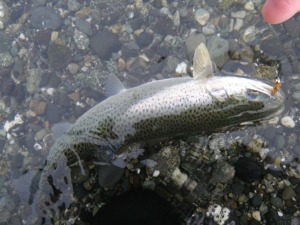The sea run cutthroat fly and probably the most widely known and used sea run cutthroat pattern today. A great anytime of the year pattern orginated by Tom Murray for estuarine sea run cutthroat. Intended originally to be a stickleback imitator, it has caught me coho, rainbows, browns, smallmouth and largemouth bass and of course, many sea run and resident cutthroat. It has also incidentally caught me chinook, chum, winter steelhead, and all kinds of intertidal beach species. Like many of the best patterns effectiveness and simplicity define this pattern. It is tied sparse and skinny to imitate slim profile baitfish like stickleback. It can be tied in many many variations of size (large head to imitate sculpin) and colour depending on local forage, or as an attractor such as the blue versions used for coho. No BC sea run cutthroat fly box would be remotely complete without it.

Tying them sparse is key, I usually tie them like this and then trim on the river or beach as needed.

Hook:
Salt: gamagatsu ss15 size 12-14 or mustad saltwater (short shank) size 8
Fresh: This fly can be tied on any hook you like, however I recommend a finer wire, shorter shanked hook for cutthroat as they hook deeper and bleed easier than other species, i usually use a tiemco short shanked size 8 or 10 hook and tie the body longer. While much is written about short striking or nipping cutthroat takes, I find that a fly tied longer than the hook with a small thin wire short shanked hook rarely nets less hookups.
I usually tie them for fresh or salt about an inch to an inch and a half long, you can go larger, but instead of increasing hook size just lengthen the wing. Those big streamer hooks (4xl +) in my experience tend to cause lots of bleeding cutthroat. The longer shanked patterns shown are old ones that I don’t use anymore for this reason.
mouthful of muddler / trout education

Thread: red to fire orange
Tail: Small pinch of rolled natural mallard flank…or teal, widgeon, or other barred feather dyed or natural depending on the colour of the deer hair or your preference, a bit short of the full length of the wing.
Body: gold or silver tinsel, overwrapped in an opposite direction with gold or silver oval tinsel (or wire, light mono) for durability, I have seen both olive/silver and olive/gold coloured stickleback in local areas. The rigours of casting and the cutthroats fine teeth shred tinsel fairly quickly if it is not glued or counter wrapped.
Wing: small section of rolled (rolled in your fingers) mallard flank fibres placed a bit longer than the tail. I sometimes add a small amount of yellow polar bear or sub in the wing when tying them for sea runs. Some people put a few strands of krystal flash or UV material in the wing as a variation, I’ve never seen a difference in catch rates with or without.
Head: olive deer hair tied in sparse and trimmed around the head in a triangle shape with a small amount of fibres (only 4-5 strands in the original pattern) running back along the body. Black, blue, white, cream, green, chartreuse, gray, dark brown, and natural deer hair have all worked well, and don’t write off moose, caribou and elk hair versions as they have all been successful for me as well. There is no “too sparse” for this fly, the more chewed and wrecked they are the better they fish. Honestly, even if the tinsel unravels I have still caught fish. It is very easy with these flies to get frustrated trying to spin the perfect head, my advice is don’t worry, this pattern is designed to catch fish, not look pretty in your vise.
Beadhead: optional, adds a bit of movement when stripping the fly in, good for faster water but not necessary, and on shallow gradient beaches usually a detriment
The book “The Gilly: A fly fishers guide” by Alfred Davy (usually available on amazon) features many interesting stories about the origin and use of fly patterns in BC and there is a good chapter on the rolled muddler, which is worthwhile reading if you are interested in the history of BC fly tying and fishing. There are also mentions, history, and pictures of this fly in many other books including Fly fishing Coastal Cutthroat by Les Johnson, Contemporary fly patterns of British Columbia and Fly patterns of British Columbia both by Art Lingren, amongst others.

Each muddler usually looks a little different, and in all the books I have from Les Johnson, to Chester Allen, to Art Lingren, to commercially tied flies, each one is tied a little different, don’t get too hung up on a particular exact look being required, as long as it is sparse it should work.












